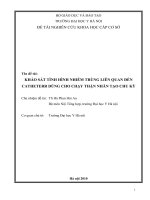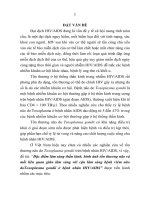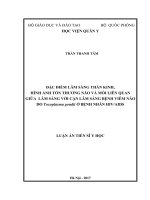Nhiễm trùng liên quan đến chỉnh hình từ khoa học cơ bản đến quản lý lâm sàng
Bạn đang xem bản rút gọn của tài liệu. Xem và tải ngay bản đầy đủ của tài liệu tại đây (4.96 MB, 46 trang )
POST-TRAUMATIC SEPTIC ARTHRITIS
TS BS Vũ Xuân Thành
GV BM CTCH- PHCN ĐHYD TP. HCM
CME liên chuyên ngành Bộ Môn CTCH-PHCN
“NHIỄM TRÙNG LIÊN QUAN ĐẾN CHỈNH HÌNH :
TỪ KHOA HỌC CƠ BẢN ĐẾN QUẢN LÝ LÂM SÀNG”
TP. HCM 16/9/2023
DEFINITION
What is septic arthritis?
▪ Septic arthritis is an imflammation of synovial membrane with purulent
effusion into the joint capsule due to infection
▪ Also referred as infectious arthritis
▪ Septic arthritis is akey consideration in adults presenting with acute monoarticular
arthritis
DEFINITION
What is septic arthritis?
▪ Considered as medical emergency
▪ Failure to initiate appropriate antibiotic therapy within the first 24 to 48 hours of
onset can cause subchondral bone loss and permanemt joint dysfunction
▪ It can cause septic shock, which can be fatal
ANATOMY
SYNOVIAL JOINT
Prevents grinding of the bone
and allow for smooth articulation
Protection of joint cavity
Lines joint & cavity and secretes
synovial fluid for lubrication
Synovial membrane
Articular cartilage
Fibrous joint capsule
Joint cavity filled with
synovial fluid
Ligaments
ANATOMY
Colour code
Ball and socket
Hinge
Pivot
Gliding
Condyloid
Saddle
EPIDEMIOLOGY
The prevalence of bacterial arthritis as the diagnosis among adults presenting with
one or more acutely painful joints has been estimated to range from 8% - 27%
All age groups, infants and older adults are most likely to
develop septic arthritis
50% < age 3
M=F
Infant
Hip
Children
Knee
Adults
Large Joints
ICDU
Sacroiliac joint
The knee is the most commonly affected but any joint may be involved
CAUSES
The infection can originate anywhere in the body
May also begin as the result of an open wound,
trauma, surgery, or unsterile injection
Septic arthritis occurs when the infective
organism travels through blood stream to the
joints
The infection can be caused by bacteria, virus or fungus
Routes of bacterial
infection (A)
(1) by hematogenous spread
(2) from an adjacent infected tissue
(3) through infected bones
(4) as a consequence of trauma
(5) during diagnostic procedures
Risk factors for
septic arthritis
development (B)
- Such as presence of other
rheumatic or immunosuppressive
diseases
- Prosthetic surgery
- And higher age
Post-traumatic
septic arthritis
Predominantly
in young
healthy males
The knee is the
most commonly
affected but any
joint may be
involved
Four distinct
origins differ in
pathogenesis and
microbiology
- Bites
- Thorn punctures
- And trauma sustained in
terrestrial
- Or aquatic environments
AETIOLOGY
Age
Organisms
1
Neonates
Streptococcus sp
Gram-negative organisms
2
Infants
3
Children
Staphylococcus aureus
Haemophilis influenza
Staphylococcus aureus
Salmonella
4
Adolescent
Staphylococcus aureus
Neisseria gonorrhea
5
Adults
Staphylococcus aureus
Streptococcus
Gram-negative organisms
6
IV Drug Abusers
Suspect Pseudomonas and atypical organisms
AETIOLOGY
1. AGE
Age > 80 years old
2. EXISTING JOINT PROBLEMS
Chronic diseases and conditions that affect the joints — such as osteoarthritis, gout, rheumatoid arthritis or
lupus — can increase the risk of septic arthritis, as can an artificial joint, previous joint surgery and joint injury.
3. MEDICATIONS
Taking medications for rheumatoid arthritis. People with rheumatoid arthritis have a further
increase in risk because of medications they take that can suppress the immune system, making
infections more likely to occur. Diagnosing septic arthritis in people with rheumatoid arthritis is
difficult because many of the signs and symptoms are similar.
4. SKIN FRAGILITY
Skin that breaks easily and heals poorly can give bacteria access to your body. Skin conditions such
as psoriasis and eczema increase your risk of septic arthritis, as do infected skin wounds. People
who regularly inject drugs also have a higher risk of infection at the site of injection.
AETIOLOGY
5. WEAK IMMUNE SYSTEM
People with a weak immune system are at greater risk of septic arthritis. This includes people with
diabetes, kidney and liver problems, and those taking drugs that suppress their immune systems.
6. ALCOLOISM AND IVDU
Having a combination of risk factors puts you at greater risk
than having just one risk factor does
AETIOLOGY
Table 1. Risk Factors for Septic Arthritis
Contiguous spread
Hematogenous spread (continued)
Skin infection, cutaneous ulcers8,9
Immunosuppressive medication9,11 Intravenous drug
Direct inoculation
abuse"
Previous intraarticular injection8.10 Prosthetic joint:
Osteoarthritis9
early and delayed8 (Table 6)
Other cause of sepsis9
Recent joint surgery8,10
Prosthetic joint: late8 (Table 6) Rheumatoid arthritis8,9
Hematogenous spread
Sexual activity (specifically for gonococcal arthritis)12
Diabetes mellitus8,10
Other factors
Human immunodeficiency virus infection11
Age older than 80 years8
PATHOPHYSIOLOGY
PATHOPHYSIOLOGY
HEMATOGENOUS SPREAD
Most common form of spread, usually
affects people with underlying medical problems
DIRECT INNOCULATION
May result from penetrating trauma,
introduction of organisms during
diagnostic and surgical procedures.
E.g. intra-articular injection
DIRECT SPREAD FROM ADJACENT BONE
More common in children. Osteomyelitis usually begins in the metaphyseal region, from which it breaks through
the periosteum into the joint
PATHOPHYSIOLOGY
PATHOPHYSIOLOGY
CLINICAL FEATURES
DIFFERENTIAL
DIAGNOSIS
Acute osteomyelitis
Rheumatic fever
Trauma
Juvennile
rheumatoid arthritis
Gaucher’s disease
Hemophilic bleed
Sickle-cell disease
Gout and pseudogout
SEPTIC ARTHRITIS SUSPECTED
BLOOD AND SYNOVIAL FLUID SAMPLE
EMPIRIC PARENTERAL ANTIBIOTICS BASED ON GRAM STAIN
JOINT DRAINAGE
ADJUST ANTIBIOTICS BASED ON CULTURE AND SENSITIVITY RESULT
INVESTIGATION
2. IMAGING
1. BLOOD INVESTIGATIONS
• Raised WCC
• Raised ESR and CRP
• Blood culture (positive)
• X-ray
• Early stage: May look normal except
widening of joint space, ultrasound helpful
3. SYNOVIAL
FLUID
ANALYSIS
• Late stage: Narrowing and irregularity of
joint space; may have OM changes of
adjacent bones
• MRI and radionuclide imaging are helpful in
diagnosing arthritis in obscure sites such as
the sacroiliac and steno-clavicular joint









